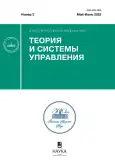FORMATION OF GROUPS OF IDENTICAL OBJECTS
- Authors: Antipov I.F.1, Dulin S.K.2, Ryabtsev A.B.3,4
-
Affiliations:
- Volgograd State University
- Research and Design Institute of Informatization, Automation and Communications in Railway Transport (JSC NIIAS)
- Federal Research Center “Computer Science and Control” of the RAS
- Moscow Institute of Physics and Technology
- Issue: No 3 (2025)
- Pages: 113-120
- Section: ARTIFICIAL INTELLIGENCE
- URL: https://ogarev-online.ru/0002-3388/article/view/304412
- DOI: https://doi.org/10.31857/S0002338825030118
- EDN: https://elibrary.ru/bgygzl
- ID: 304412
Cite item
Abstract
Keywords
About the authors
I. F. Antipov
Volgograd State University
Email: antipov.ivan.f@gmail.com
Volgograd, Russia
S. K. Dulin
Research and Design Institute of Informatization, Automation and Communications in Railway Transport (JSC NIIAS)
Email: skdulin@mail.ru
Moscow, Russia
A. B. Ryabtsev
Federal Research Center “Computer Science and Control” of the RAS; Moscow Institute of Physics and Technology
Email: ryabtsev.ab@phystech.edu
Moscow, Russia; Moscow, Russia
References
- Creps R., Polzer H., Yanosy J. Systems, capabilities, operations, programs, and enterprises (SCOPE). Model for interoperability assessment // NetworkCentric Operations Industry Consortium, 2008. P. 154.
- GOST R 55062-2012. Information Technology (IT). Industrial Automation Systems and Their Integration. Interoperability. Basic Provisions // Standartinform. 2014. P. 12.
- Baas J., Dastani M., Feelders J. Exploiting Transitivity for Entity Matching // The Semantic Web: ESWC Satellite Events: Virtual Event. Revised Selected Papers 18. Cham: Springer International Publishing, 2021. P. 109–114.
- Dulin S.K. Introduction to the Theory of Structural Coherence. M.: Computing Center of the Russian Academy of Sciences, 2005. P. 135.
- Rosenberg I.N., Dulin S.K., Dulina N.G. Modeling the Structure of Interoperability by Means of Structural Consistency // Computer Science and its Applications. 2023. V. 17. P. 57–65.
- Papadakis G., Svirsky J., Gal A. et al. Comparative Analysis of Approximate Blocking Techniques for Entity Resolution // Proc. VLDB Endowment. 2016. V. 9. P. 684–695.
- Miao Z., Li Y., Wang X. Rotom: A meta-learned data augmentation framework for entity matching, data cleaning, text classification, and beyond // Proc. Intern. Conf. on Management of Data. Xi’an. 2021. P. 1303–1316.
- Thirumuruganathan S., Li. H, Tang N. et al. Deep Learning for Blocking in Entity Matching: a Design Space Exploration // Proc. VLDB Endowment. 2021. V. 14. P. 2459–2472.
- Dulin S.K., Ryabtsev A.B. Algorithm for Improving the Consistency of Structural Interoperability. Dependability, 2024. P. 8–15.
- Zhu X., Zoubin G. Learning from labeled and unlabeled data with label propagation // Tech. Rep., Technical Report CMU-CALD-02–107. Carnegie Mellon University, 2002. https://mlg.eng.cam.ac.uk/zoubin/papers/CMUCALD-02-107.pdf https://github.com/graphframes/graphframes
- Kaufman L., Rousseeuw P.J. Finding groups in data: an introduction to cluster analysis. John Wiley & Sons, 2009.
- Rosenberg A., Hirschberg J. V-Measure: a conditional entropy-based external cluster evaluation measure, 2007.
- Fowkles E., Mallows C. A method for comparing two hierarchical clusterings // J. American Statistical Association. 1983. V. 78. P. 553–569.
- Rand W. Objective criteria for the evaluation of clustering methods // J. American Statistical Association. 1971. V. 66. P. 846–850.
- Hubert L., Arabie P. Comparing partitions // J. Classification. 1985. V. 2. P. 193–218.
Supplementary files









